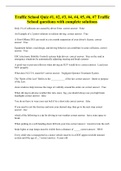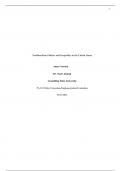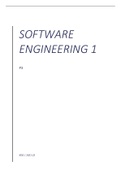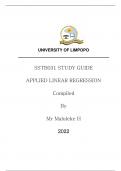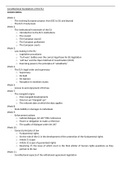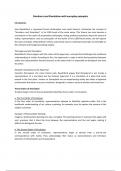How am I doing?
Within unit 2, I have performed varied practical work: titration, colorimetry, calorimetry, paper
chromatography and TLC. This is a progress report to evaluate the procedures and techniques required
to perform these experiments.
To obtain accurate data, an accuracy procedure which is commonly carried out is calibration; this is the
process of checking equipment to ensure there are no faults that could affect the accuracy of the
results. I have learnt that specific equipment being used must be calibrated throughout the experiment;
if not, the results will have a higher uncertainty. Each piece of equipment has a calibration method
individual to its function which needs to be researched before the experiment. These are the calibration
procedures I have utilised so far:
Piece of equipment Calibration method
Beaker/conical flask/measuring cylinder Rinse out with distilled water to remove any
residue. Also, ensure there are no cracks/chips
because if there is product could be lost.
Burette Invert and dispense around 20ml of distilled
water. Use a clamp stand and clamp to hang
this over a beaker to drain for a minimum of 3
mins. Then, keeping the beaker under the
burette, dispense the solution being used to
make sure the jet space is filled.
Glass and dropping pipette Repeatedly pipette distilled water to remove
any residue. Ensure there are no water droplets
within the pipette before using it.
2d.p scales Ensure that the scales are 00.00 when turned
on and measure a known mass to test the
accuracy of the scales.
pH meter Prepare 3 buffer solutions of known pH’s. There
should be a pH of 7 (water), a pH of 4 and a pH
of 10 to create the pH curve.
1) Ensure the pH meter is switched on and
rinse the pH probe.
2) Place the pH meter into a buffer
solution and press the calibrate button
to get a reading.
3) Repeat this for the other solutions.
4) Plot a graph of the buffer pH against
the measured ph. If the pH meter is
accurate the line of best fit should be a
straight line from the origin.
Colorimeter Roughly fill a cuvette to ¾ with distilled water,
place the cuvette in the colorimeter and close
the lid. Select a wavelength/colour filter, press
, the CAL button on the colorimeter and release
the button when it starts flashing red. If the
colorimeter is working the absorbance reading
should be 0.0000.
Liquid/Digital Thermometer Part one:
1. Roughly fill a 250cm❑3❑ beaker with at
least 150cm❑3❑ of boiling water.
2. Submerge the tip of the thermometer
into the beaker, ensuring that you hold
it in a position that it does not touch
the sides of the beaker. This can affect
the accuracy of the reading because the
thermometer will read the heat of the
beaker instead of just the substance.
3. Take readings of the water temperature
at minute intervals. Do this for three
minutes.
Part two:
1. Roughly fill at least half of a 250cm❑3❑
beaker with ice.
2. Submerge the tip of the thermometer
into the beaker, ensuring that you do
not touch the sides of the beaker.
3. Take readings of the ice temperature at
minute intervals. Do this for three
minutes.
A few other general procedures and techniques I have learnt to always carry out when doing practical
work include:
Safety procedures to reduce the risk of hazards:
To prevent the risk of the hazard; lab coats, eye protection (safety glasses/goggles) and rubber gloves
should be worn whilst handling these chemicals. Also, avoid using high concentrations where possible.
If physical contact with chemicals does occur, rinse the exposed area with distilled water. If the
substance is spilt on a surface, wipe it with a damp cloth (if it is an anhydrous substance, avoid lifting
dust particles into the air). If symptoms occur, seek medical attention immediately. The symptoms are
not foreseeable.
Minor scratches/cuts should be washed and have a small, sterile dressing applied to it. For severe cuts,
sit down and apply pressure to the wound using a sterile dressing. Seek immediate medical attention.
Treat burns by rinsing it with cold water and seek medical attention for severe burns.
, However, for each experiment I have completed a risk assessment of the substances involved because
when being prepared to carry out my first experiment, I learnt that individual substances have their
specific hazards. The state and concentration of the substance also needs to be considered.
Risk assessments can also be of equipment. So, here is an example of a risk assessment which can be
applied to most if not all experiments:
Substance Hazard Comment Prevention
Glassware Danger Glassware is brittle meaning it -Be delicate when handling any
can easily crack and form sharp glassware equipment.
shards of glass. This could cause -Do not place any glassware in
scratches or more serious an unstable position.
puncture wounds such as deep -Do not place any glassware near
cuts. the edge of a surface.
Depending on the experiment I had to record the results data in different ways. So, I have learnt
to recognise how to record the data depending on what I am trying to conclude or calculate.
Across all the experiments, I have learnt to correctly record data in the form of tables and to
plot a line graph with it. Line graphs can be used to observe the range of results and make an
estimation.
When preparing any type of solution, you should make up the solution in an open container like
a beaker, allowing you to use a glass rod to mix it with. Then, if a sample is transferred to
another container, invert the solution to ensure the contents are fully mixed.
Titration
The objective of this experiment is to accurately calculate the concentration of solutions.
This experiment exemplifies that neutralizing a solution of unknown concentration with a solution of
known concentration allows us to use the molar ratio of the neutralisation equation to calculate the
unknown concentration. This use of titration is called standardization. Procedures and techniques I
learnt to utilise during this experiment were the following:
o During this experiment, I learnt that a solution of a known concentration is called a standard
solution. I had to prepare an alkali standard solution to be neutralised. So, I prepared a 250cm
3
❑❑ solution of sodium carbonate. To do so I chose a low concentration of 0.1M and calculated
the sodium carbonate I would require doing so with the following equations:
Moles (n) = concentration (moldm−3 3
❑❑ ) × volume (dm❑❑) → Moles = 0.1 × (250 ÷ 1000) = 0.025
Mass (g) = moles × RFM →RFM = (23×2) + 12 + (16×3) = 106 →Mass = 0.025 × 106 = 2.65
o When I measured the anhydrous sodium carbonate, using a weighing bottle to do so, I
measured the weight of the weighing bottle before and after transferring the substance to
Within unit 2, I have performed varied practical work: titration, colorimetry, calorimetry, paper
chromatography and TLC. This is a progress report to evaluate the procedures and techniques required
to perform these experiments.
To obtain accurate data, an accuracy procedure which is commonly carried out is calibration; this is the
process of checking equipment to ensure there are no faults that could affect the accuracy of the
results. I have learnt that specific equipment being used must be calibrated throughout the experiment;
if not, the results will have a higher uncertainty. Each piece of equipment has a calibration method
individual to its function which needs to be researched before the experiment. These are the calibration
procedures I have utilised so far:
Piece of equipment Calibration method
Beaker/conical flask/measuring cylinder Rinse out with distilled water to remove any
residue. Also, ensure there are no cracks/chips
because if there is product could be lost.
Burette Invert and dispense around 20ml of distilled
water. Use a clamp stand and clamp to hang
this over a beaker to drain for a minimum of 3
mins. Then, keeping the beaker under the
burette, dispense the solution being used to
make sure the jet space is filled.
Glass and dropping pipette Repeatedly pipette distilled water to remove
any residue. Ensure there are no water droplets
within the pipette before using it.
2d.p scales Ensure that the scales are 00.00 when turned
on and measure a known mass to test the
accuracy of the scales.
pH meter Prepare 3 buffer solutions of known pH’s. There
should be a pH of 7 (water), a pH of 4 and a pH
of 10 to create the pH curve.
1) Ensure the pH meter is switched on and
rinse the pH probe.
2) Place the pH meter into a buffer
solution and press the calibrate button
to get a reading.
3) Repeat this for the other solutions.
4) Plot a graph of the buffer pH against
the measured ph. If the pH meter is
accurate the line of best fit should be a
straight line from the origin.
Colorimeter Roughly fill a cuvette to ¾ with distilled water,
place the cuvette in the colorimeter and close
the lid. Select a wavelength/colour filter, press
, the CAL button on the colorimeter and release
the button when it starts flashing red. If the
colorimeter is working the absorbance reading
should be 0.0000.
Liquid/Digital Thermometer Part one:
1. Roughly fill a 250cm❑3❑ beaker with at
least 150cm❑3❑ of boiling water.
2. Submerge the tip of the thermometer
into the beaker, ensuring that you hold
it in a position that it does not touch
the sides of the beaker. This can affect
the accuracy of the reading because the
thermometer will read the heat of the
beaker instead of just the substance.
3. Take readings of the water temperature
at minute intervals. Do this for three
minutes.
Part two:
1. Roughly fill at least half of a 250cm❑3❑
beaker with ice.
2. Submerge the tip of the thermometer
into the beaker, ensuring that you do
not touch the sides of the beaker.
3. Take readings of the ice temperature at
minute intervals. Do this for three
minutes.
A few other general procedures and techniques I have learnt to always carry out when doing practical
work include:
Safety procedures to reduce the risk of hazards:
To prevent the risk of the hazard; lab coats, eye protection (safety glasses/goggles) and rubber gloves
should be worn whilst handling these chemicals. Also, avoid using high concentrations where possible.
If physical contact with chemicals does occur, rinse the exposed area with distilled water. If the
substance is spilt on a surface, wipe it with a damp cloth (if it is an anhydrous substance, avoid lifting
dust particles into the air). If symptoms occur, seek medical attention immediately. The symptoms are
not foreseeable.
Minor scratches/cuts should be washed and have a small, sterile dressing applied to it. For severe cuts,
sit down and apply pressure to the wound using a sterile dressing. Seek immediate medical attention.
Treat burns by rinsing it with cold water and seek medical attention for severe burns.
, However, for each experiment I have completed a risk assessment of the substances involved because
when being prepared to carry out my first experiment, I learnt that individual substances have their
specific hazards. The state and concentration of the substance also needs to be considered.
Risk assessments can also be of equipment. So, here is an example of a risk assessment which can be
applied to most if not all experiments:
Substance Hazard Comment Prevention
Glassware Danger Glassware is brittle meaning it -Be delicate when handling any
can easily crack and form sharp glassware equipment.
shards of glass. This could cause -Do not place any glassware in
scratches or more serious an unstable position.
puncture wounds such as deep -Do not place any glassware near
cuts. the edge of a surface.
Depending on the experiment I had to record the results data in different ways. So, I have learnt
to recognise how to record the data depending on what I am trying to conclude or calculate.
Across all the experiments, I have learnt to correctly record data in the form of tables and to
plot a line graph with it. Line graphs can be used to observe the range of results and make an
estimation.
When preparing any type of solution, you should make up the solution in an open container like
a beaker, allowing you to use a glass rod to mix it with. Then, if a sample is transferred to
another container, invert the solution to ensure the contents are fully mixed.
Titration
The objective of this experiment is to accurately calculate the concentration of solutions.
This experiment exemplifies that neutralizing a solution of unknown concentration with a solution of
known concentration allows us to use the molar ratio of the neutralisation equation to calculate the
unknown concentration. This use of titration is called standardization. Procedures and techniques I
learnt to utilise during this experiment were the following:
o During this experiment, I learnt that a solution of a known concentration is called a standard
solution. I had to prepare an alkali standard solution to be neutralised. So, I prepared a 250cm
3
❑❑ solution of sodium carbonate. To do so I chose a low concentration of 0.1M and calculated
the sodium carbonate I would require doing so with the following equations:
Moles (n) = concentration (moldm−3 3
❑❑ ) × volume (dm❑❑) → Moles = 0.1 × (250 ÷ 1000) = 0.025
Mass (g) = moles × RFM →RFM = (23×2) + 12 + (16×3) = 106 →Mass = 0.025 × 106 = 2.65
o When I measured the anhydrous sodium carbonate, using a weighing bottle to do so, I
measured the weight of the weighing bottle before and after transferring the substance to



